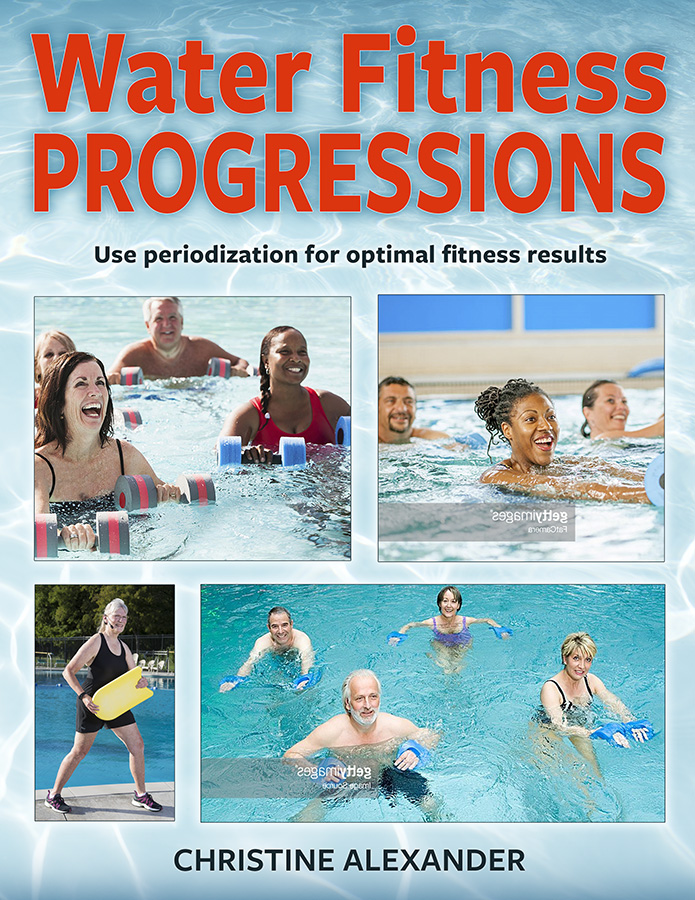
There are those who are passionate about deep-water exercise (and I am one of them). But for those who have never tried it, there is a degree of mystery about it. One of the concerns I hear most often is: “I don’t think I could tread water for an entire one-hour class.” You don’t have to! Everyone should wear a flotation belt in deep water. The second concern I hear is: “Can you get a workout in deep water as intense as the workout in shallow water? And the answer is definitely, yes!

Let’s back up to that flotation belt. It needs to be attached tightly around your waist so that it doesn’t slide up under your arm pits. And then you need some practice stabilizing, since your feet don’t touch the pool floor and there may be a tendency to tip forward or backward. The core muscles have to learn to contract to keep you upright, which is why most people see improvements in their core strength after taking a deep-water class for awhile. The second thing you need to learn is to continue to maintain that upright position in which you work against the water’s resistance with your entire body from the neck down, instead of trying to streamline by rounding forward, as in the drawing with the big X through it. In this position the bones of your spine are compressed on the front side, which is not good for the back.
Now, let’s talk about getting an intense workout in deep water. This means high intensity interval training (HIIT) where you work at 80-90% of your maximum effort for short periods followed by periods of active recovery. Achieving maximum effort requires focus. Your focus determines the number of muscle fibers that need to contract and the speed of those contractions. It’s important, then, that you are actively engaged, not reminiscing about vacation or chatting with another participant, when you are performing HIIT. The strategies for achieving high intensity in deep water are similar to the strategies in shallow water, but with some differences.
Step One: Start with the Base Moves. In deep water the base moves are jog, bicycle, kick, cross-country ski, and jumping jacks. These moves all have multiple variations. (1) Jog. You can jog with the feet hip distance apart or wide. You can cross the midline in front with an inner thigh lift or cross the midline in back with hopscotch. You can lift the knees in front or the heels in back. You can lean diagonally to the side or go all the way to side-lying. (2) Bicycle. Bicycle with the feet under you as if you are on a unicycle. You can bicycle tandem, with the feet pedaling in unison. You can lean diagonally to the side or go all the way to side-lying. (3) Kick. You can flutter kick, kick forward, kick across the midline, Cossack kick like a Russian dancer, or kick backward. (4) Cross-country ski. You can ski upright, add a tuck, lean diagonally to the side or go all the way to side-lying. (5) Jumping jacks. You can add a tuck or perform the jacks seated, with knees bent or in an “L” position. All the base moves can be varied by using different arm movements or different foot positions.
Step Two: Increase the Range of Motion. Large moves take more effort than smaller moves. Increasing the range of motion is one intensity variable. Get the knees high in your jog and pump the arms in big movements. Start your inner thigh lift with the feet wide apart and lift the inner thigh high. Start your hopscotch with the feet wide too. Bicycle in large round circles. Kick higher – front or back. Perform cross-country ski with your full range of motion, or do a helicopter ski, moving the legs in semi-circles around the body instead of in straight lines. Take your feet as wide as comfortably possible in your jumping jacks and cross the legs in the center. Focus on achieving your full range of motion. Depending your level of fitness, you may find large moves to be really intense. Alternate base moves with exercises using full range of motion for your intervals until that becomes easier.
Step Three: Add Speed. Faster moves increase intensity. The tendency, however, is to decrease the range of motion as speed is increased. You work much harder if you maintain the same full range of motion while speeding up. Pay attention to your exercises to avoid slowing down. Speed is a second intensity variable. Alternate base moves with faster exercises for your intervals until that becomes easier.
Step Four: Add Acceleration. There are two ways to do this. (1) Accelerate your leg movements toward center to lift your shoulders out of the water. This is called adding elevation. Examples are frog kick, breaststroke kick, cross-country ski, and tuck ski together (scissors kick). The body will rise and sink rhythmically. You can also use a scull to lift your shoulders out of the water with a jog, bicycle or flutter kick. Aim to stay elevated with your scull. (2) Accelerate against the water’s resistance, or add more force to the move. Take your jog to a steep climb by stretching out your arms and pressing alternating hands down while at the same time lifting the knees high and then pressing the heels down toward the pool floor, as if climbing a steep mountain with trekking poles. Lift your inner thigh with power as your press the opposite hand down forcefully toward the thigh. Bicycle with power as if you are climbing a hill in first gear. Perform a high kick powering the leg on the downward phase, or power both upward and downward. Kicks backward, cross-country ski and jumping jacks can all be performed with power. Be mindful about what you are doing because the harder you push against the water, the harder the water pushes back. Acceleration is a third intensity variable. Alternate base moves with accelerated moves for your intervals until that becomes easier.
Step Five: Combine Intensity Variables or Work in More than One Plane. One strategy for continuing to perform HIIT once you have achieved your fitness goals is to combine intensity variables. Go for full range of motion with power, elevation with speed, or power with travel continuing to use force as you move across the pool. Another strategy is to work in two or three planes at once. You can do this by alternating one move in the frontal plane, such as a frog kick with another move in the sagittal plane, such as a tuck ski together. A second way to work in multiple planes is to combine arm moves in one plane with leg moves in another plane. Examples include jumping jacks (frontal plane) with clapping hands (transverse plane); cross-country ski (sagittal plane) with arms sweeping side to side (transverse plane); and high kick (sagittal plane) clapping over the kick (transverse plane) then under the kick (frontal plane). Continue to focus on what you are doing, and your periods of high intensity will leave you breathing hard. You will need those periods of active recovery to catch your breath. For more information on interval training in both deep water and shallow water, including lesson plans using these five steps, see my book Water Fitness Progressions.
See you in the pool!



